Effect of 160 MeV Xenon Ion Irradiation on the Tribological Properties and Crystal Structure of 100Cr6 Bearing Steel
Abstract
:1. Introduction
2. Materials and Methods
3. Results and Discussion
3.1. Steel Surface Topography
3.2. Tribological Measurements
3.3. EDX Measurements
3.4. GXRD Measurements
3.5. Energy Losses of Xe Ions in the Bearing Steel Target
4. Conclusions
Author Contributions
Funding
Institutional Review Board Statement
Informed Consent Statement
Data Availability Statement
Conflicts of Interest
References
- Oyarzabal, I.M.; Tunes, M.A.; Camaraa, O.; Aradi, E.; Mir, A.H.; Greaves, G.; Hinks, J.A.; Fitchner, P.F.; Donnelly, S.E. The effect of flux on ion irradiation-enhanced precipitation in AISI-316L: An in-situ TEM study. J. Nucl. Mater. 2020, 541, 152414. [Google Scholar] [CrossRef]
- Was, G. The damage cascade. In Fundamentals of Radiation Materials Science; Springer: Berlin/Heidelberg, Germany; New York, NY, USA, 2007; pp. 125–155. [Google Scholar]
- Xu, Q.; Yokotani, T.; Sato, K.; Hori, F. Electrical resistivity measurement of Fe-0.6%Cu alloy irradiated by neutrons at 14–19 K. J. Nucl. Mater. 2016, 481, 176–180. [Google Scholar] [CrossRef]
- Gao, J.; Du, Y.; Ohnuki, S.; Wan, F. Evolution of dislocation loops in annealed iron pre-irradiated with hydrogen ion in high-voltage electron microscope. J. Nucl. Mater. 2016, 481, 81–87. [Google Scholar] [CrossRef]
- Jin, H.H.; Lim, S.; Kwon, J. Characterization of the martensite phase formed during hydrogen ion irradiation in austenitic stainless steel. Nucl. Instrum. Methods Phys. Res. B 2017, 409, 318–322. [Google Scholar] [CrossRef]
- Ren, X.L.; Yao, B.D.; Zhu, T.; Zhong, Z.H.; Wang, Y.X.; Cao, X.Z.; Jinno, S.; Xu, Q. Effect of irradiation on randomness of element distribution in CoCrFeMnNi equiatomic high-entropy alloy. Intermetallics 2020, 126, 106942. [Google Scholar] [CrossRef]
- Dutta Gupta, A.; Mukherjee, P.; Gayathri, N.; Bhattacharyya, P.; Bhattacharya, M.; Sarkar, A.; Sen, S.; Mitra, M.K. Proton irradiation studies on pure Ti and Ti-6Al-4V. Nucl. Instrum. Methods Phys. Res. B 2016, 387, 63–72. [Google Scholar] [CrossRef]
- Pogrebnjak, A.D.; Webster, R.F.; Tilley, R.D.; Buranich, V.V.; Ivashchenko, V.I.; Takeda, Y.; Oyoshi, K.; Sakenova, R.; Piotrowska, K.; Zukowski, P.; et al. Formation of Si-rich interfaces by radiation-induced diffusion and microsegregation in CrN/ZrN nanolayer coating. ACS Appl. Mater. Interfaces 2021, 13–14, 16928–16938. [Google Scholar] [CrossRef] [PubMed]
- Jin, H.H.; Hwang, S.S.; Choi, M.J.; Lee, G.G.; Kwon, J. Proton irradiation for radiation-induced changes in microstructures and mechanical properties of austenitic stainless steel AISI 316L. J. Nucl. Mater. 2019, 513, 271–281. [Google Scholar] [CrossRef]
- Jin, H.H.; Ko, E.; Lim, S.; Kwon, J.; Shin, C. Effect of irradiation temperature on microstructural changes in self ion irradiated austenitic stainless steel. J. Nucl. Mater. 2017, 493, 239–245. [Google Scholar] [CrossRef]
- Radiguet, B.; Etienne, A.; Pareige, P.; Sauvage, X.; Valiev, R. Irradiation behavior of nanostructured 316 austenitic stainless steel. J. Mater. Sci. 2018, 43, 7338–7343. [Google Scholar] [CrossRef]
- Huang, H.H.; Li, J.J.; Li, D.H.; Liu, R.D.; Lei, G.H.; Huang, Q.; Yan, L. TEM, XRD and nanoindentation characterization of Xenon ion irradiation damage in austenitic stainless steels. J. Nucl. Mater. 2014, 454, 168–172. [Google Scholar] [CrossRef]
- Budzynski, P.; Kaminski, M.; Surowiec, Z.; Wiertel, M.; Skuratov, V.A.; Korneeva, E.A. Effects of xenon-ion irradiation on the tribological properties and crystal structure of titanium and its alloy Ti6Al4V. Tribol. Int. 2021, 156, 106854. [Google Scholar] [CrossRef]
- Bringas, J.E. Handbook of Comparative World Steel Standards—ASTM Data Series Ds67b, 3rd ed.; ASTM International: West Conshohocken, PA, USA, 2004; p. 435. [Google Scholar]
- Rogozhkin, S.V.; Aleev, A.A.; Zaluzhnyi, A.G.; Kuibida, R.P.; Kulevoi, T.V.; Nikitin, A.A.; Orlov, N.N.; Chalykh, B.B.; Shishmarev, V.B. Effect of Irradiation by Heavy Ions on the Nanostructureof Perspective Materials for Nuclear Power Plants. Phys. Met. Metallogr. 2012, 113, 200–211. [Google Scholar] [CrossRef]
- Droppa, R., Jr.; Pinto, H.C.; Garcia, J.; Ochoa, E.A.; Morales, M.; Cucatti, S.; Alvarez, F. Influence of ion-beam bombardment on the physical properties of 100Cr6 steel. Mater. Chem. Phys. 2014, 147, 105–112. [Google Scholar] [CrossRef]
- Sader, J.E.; Chon, J.W.M.; Mulvaney, P. Calibration of rectangular atomic force microscope cantilevers. Rev. Sci. Instrum. 1999, 70, 3967–3969. [Google Scholar] [CrossRef]
- Horcas, I.; Fernández, R.; Gómez-Rodríguez, J.M.; Colchero, J.; Gómez-Herrero, J.; Baro, M. WSXM: A software for scanning probe microscopy and a tool for Nanotechnology. Rev. Sci. Instrum. 2007, 78, 13705. [Google Scholar] [CrossRef]
- ASTM G99-17; Standard Test Method for Wear Testing with a Pin-on-Disk Apparatus. ASTM International: West Conshohocken, PA, USA, 2017.
- Black, D.; Mendenhall, M.; Brown, C.; Henins, A.; Filliben, J.; Cline, J. Certification of Standard Reference Material 660c for powder diffraction. Powder Diffr. 2020, 35, 17–22. [Google Scholar] [CrossRef] [PubMed]
- Ziegler, J.F.; Ziegler, M.D.; Birsak, J.P. SRIM-2003. Nucl. Instrum. Methods Phys. Res. B 2004, 219–220, 1027–1036. [Google Scholar] [CrossRef]
- Dwaraknath, S.S.; Was, G.S. Radiation enhanced diffusion of cesium, strontium and europium in silicon carbide. J. Nucl. Mater. 2016, 474, 76–87. [Google Scholar] [CrossRef]
- Doyle, P.J.; Benensky, K.M.; Zinkle, S.J. Modeling the impact of radiation-enhanced diffusion on implanted ion profiles. J. Nucl. Mater. 2018, 509, 168–180. [Google Scholar] [CrossRef]
- Zhang, X.; Zhang, Z.; Akhmadaliev, S.; Zhou, S.; Wu, Y.; Guo, B. Structural and magnetic properties of swift heavy-ion irradiated SiC. Vacuum 2021, 184, 109849. [Google Scholar] [CrossRef]
- Welzel, U.; Ligot, J.; Lamparter, P.; Vermeulen, A.C.; Mittemeijer, E.J. Stress analysis of polycrystalline thin films and surface regions by X-ray diffraction. J. Appl. Cryst. 2005, 38, 1–29. [Google Scholar] [CrossRef]
- Jagielski, J.; Thomé, L. Multi-step damage accumulation in irradiated crystals. Appl. Phys. A 2009, 97, 147–155. [Google Scholar] [CrossRef]
- Zhang, S.J.; Li, D.H.; Chen, H.C.; Lei, G.; Huang, H.F.; Zhang, W.; Wang, C.B.; Yan, L.; Fu, D.J.; Tang, M. Ion irradiation-induced swelling and hardening effect of Hastelloy N alloy. J. Nucl. Mater. 2017, 489, 180–186. [Google Scholar] [CrossRef]
- Chang, S.; Tseng, K.K.; Yang, Y.T.; Chao, D.S.; Yeh, J.W.; Liang, J.H. Irradiation-induced swelling and hardening in HfNbTaTiZr refractory high-entropy alloy. Mat. Lett. 2020, 272, 127832. [Google Scholar] [CrossRef]
- Williamson, G.K.; Hall, W.H. X-ray line broadening from filed aluminium and wolfram. Acta Metall. 1953, 1, 22–31. [Google Scholar] [CrossRef]
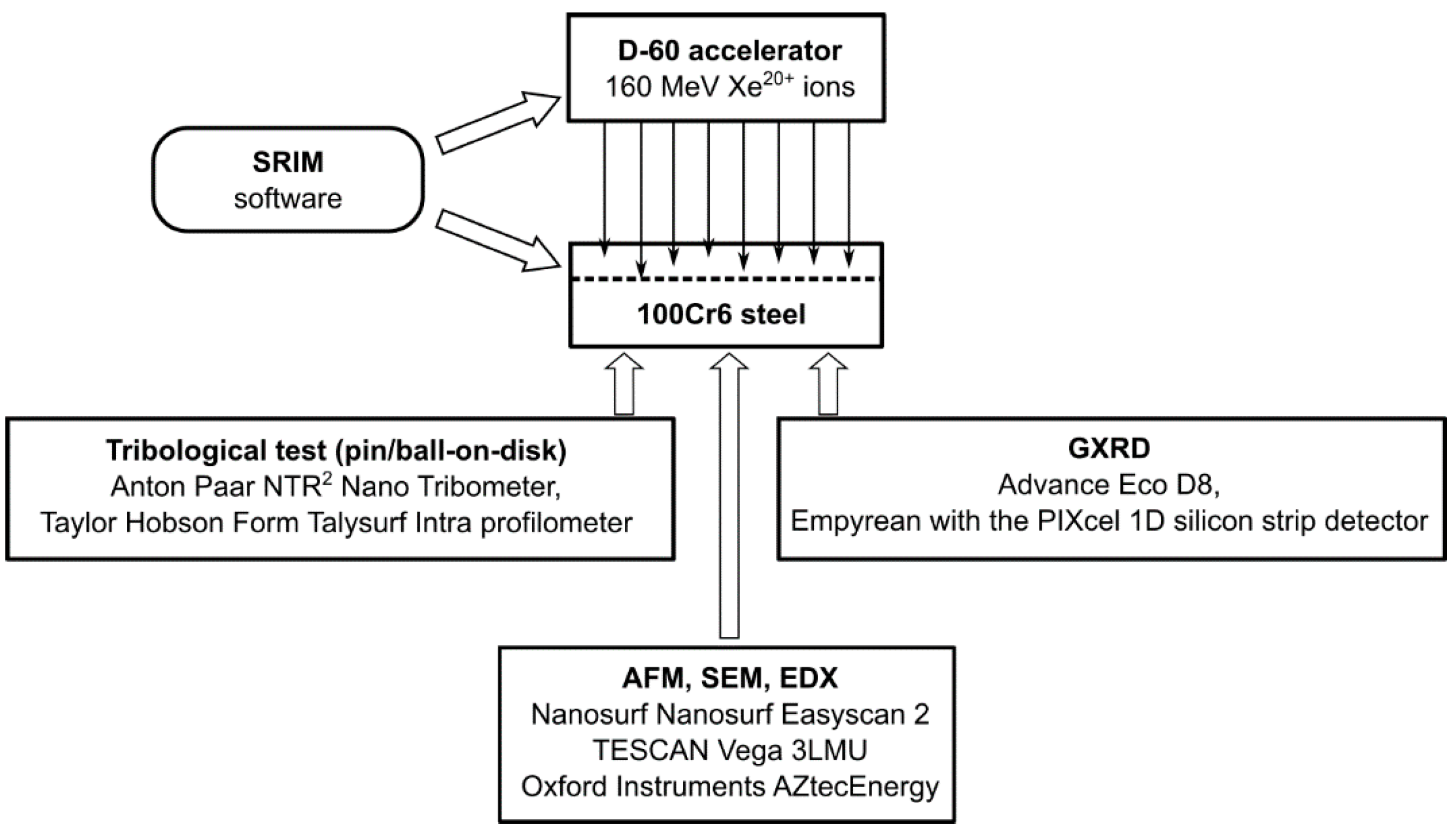
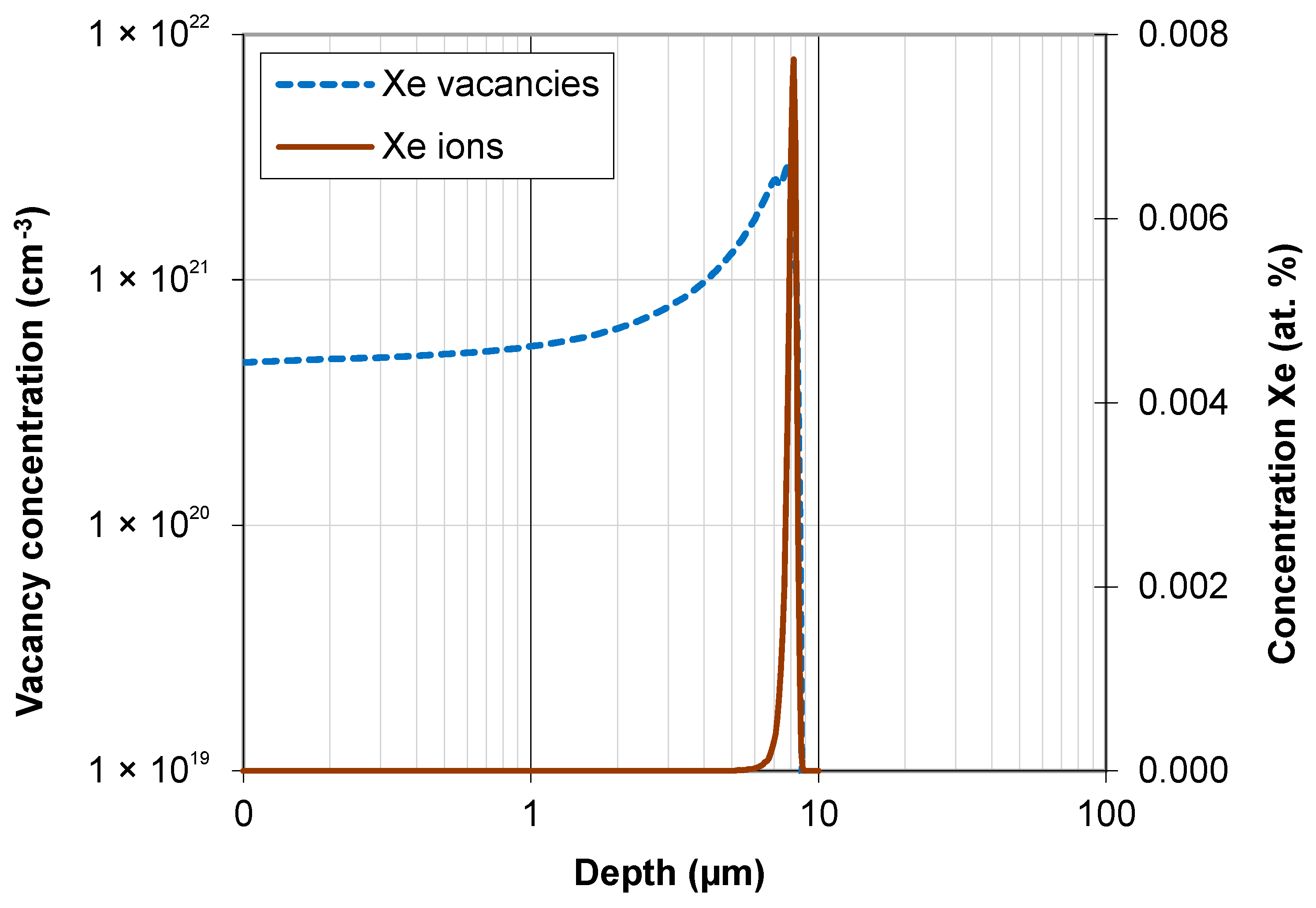
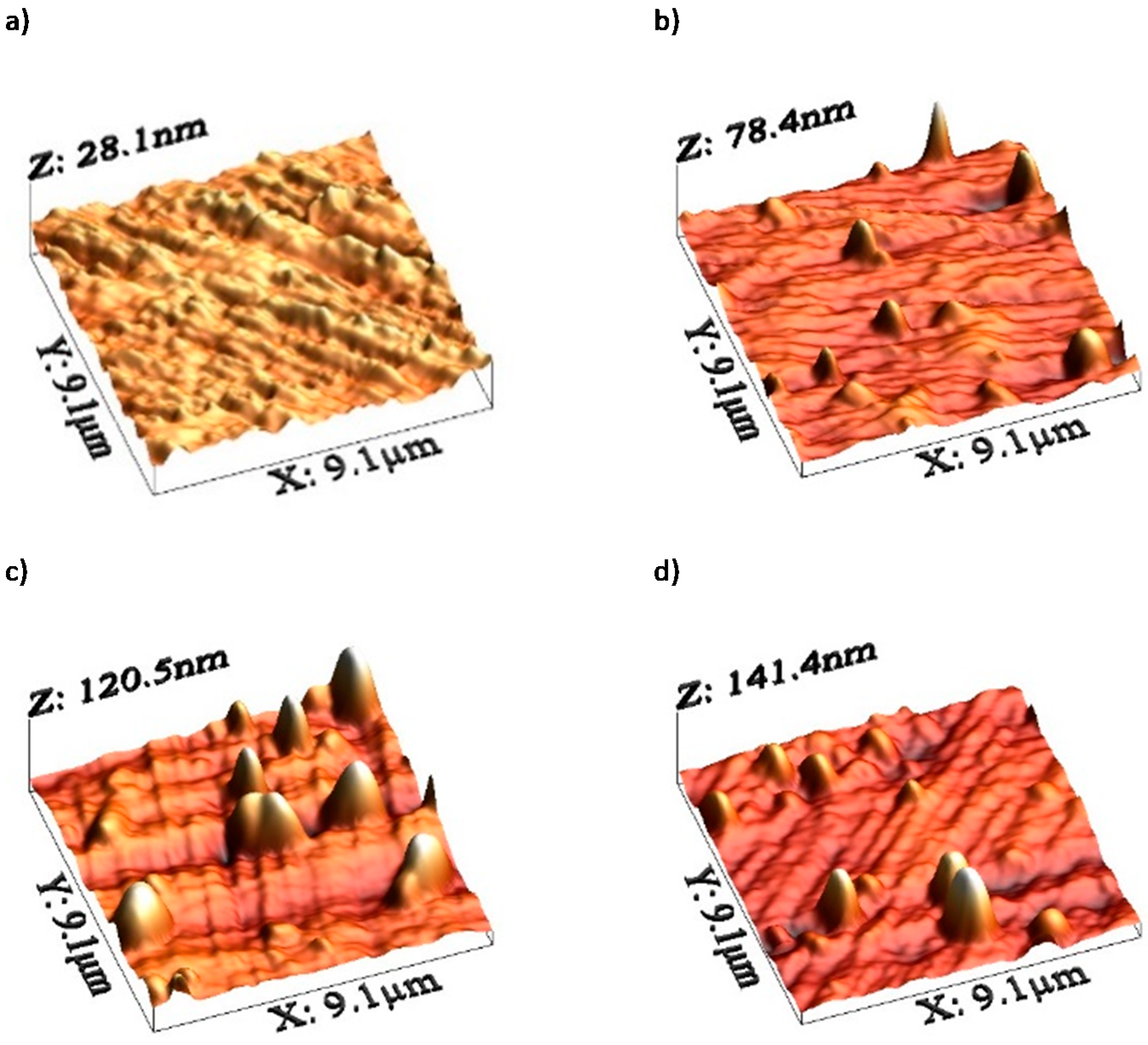
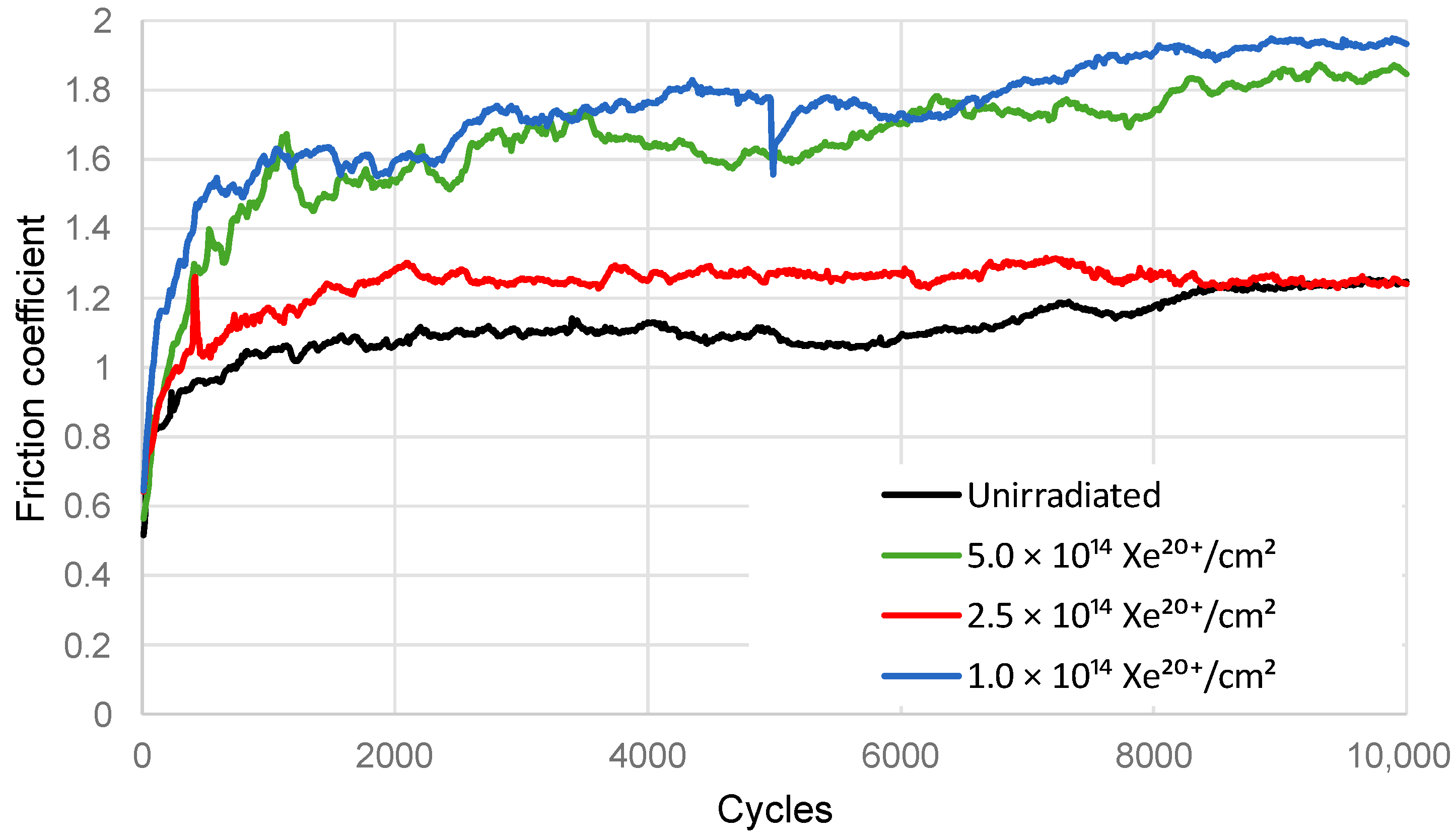

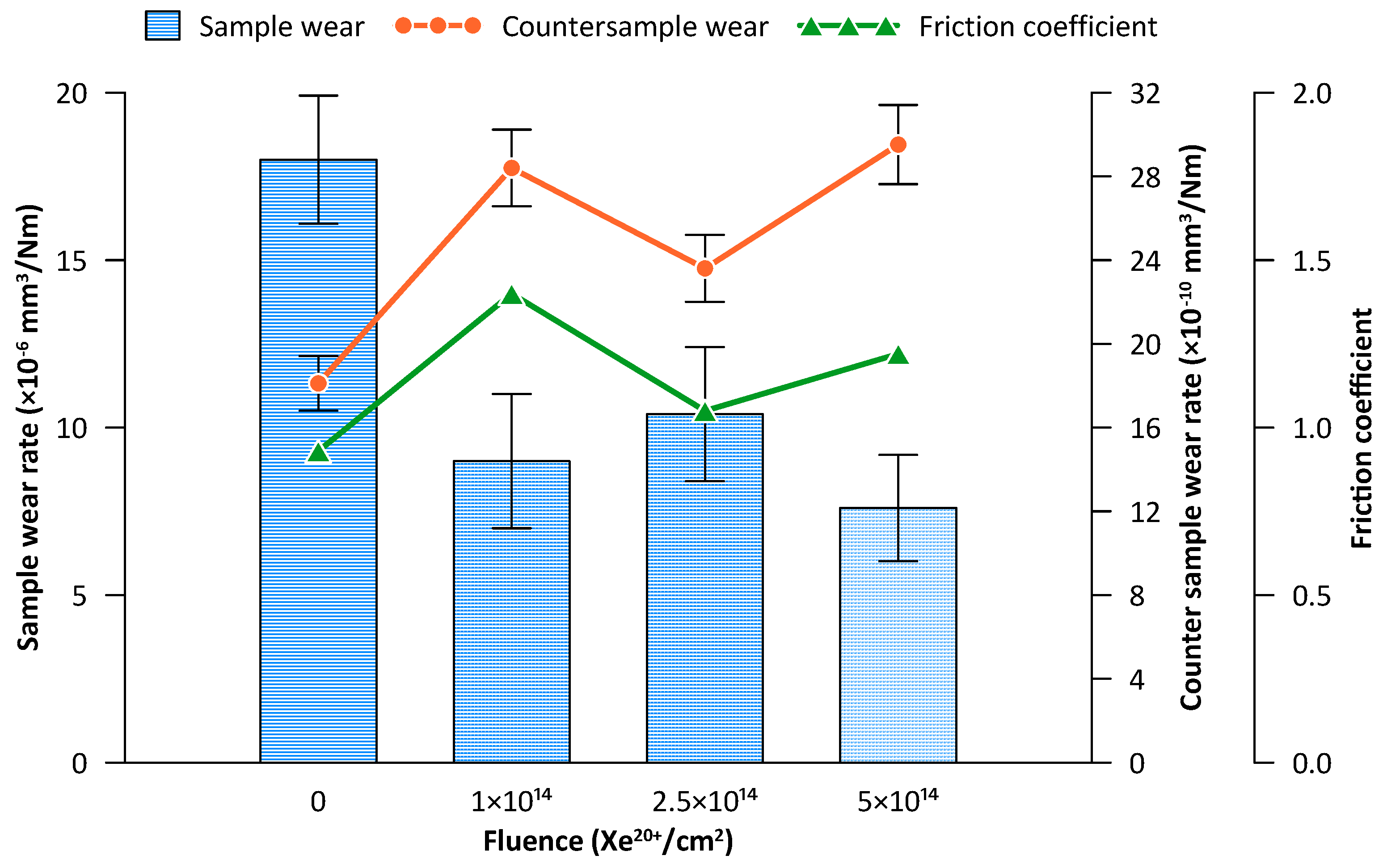
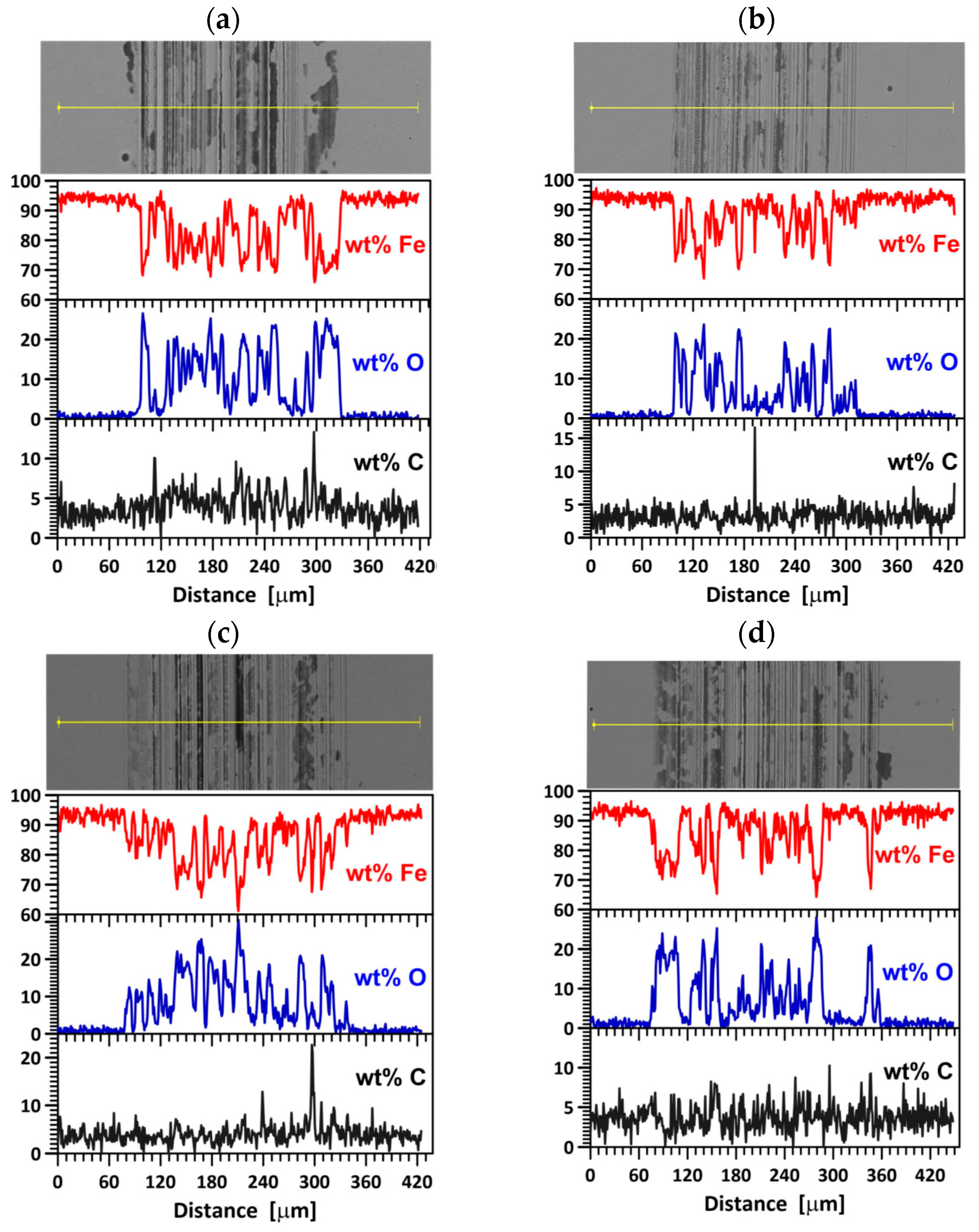
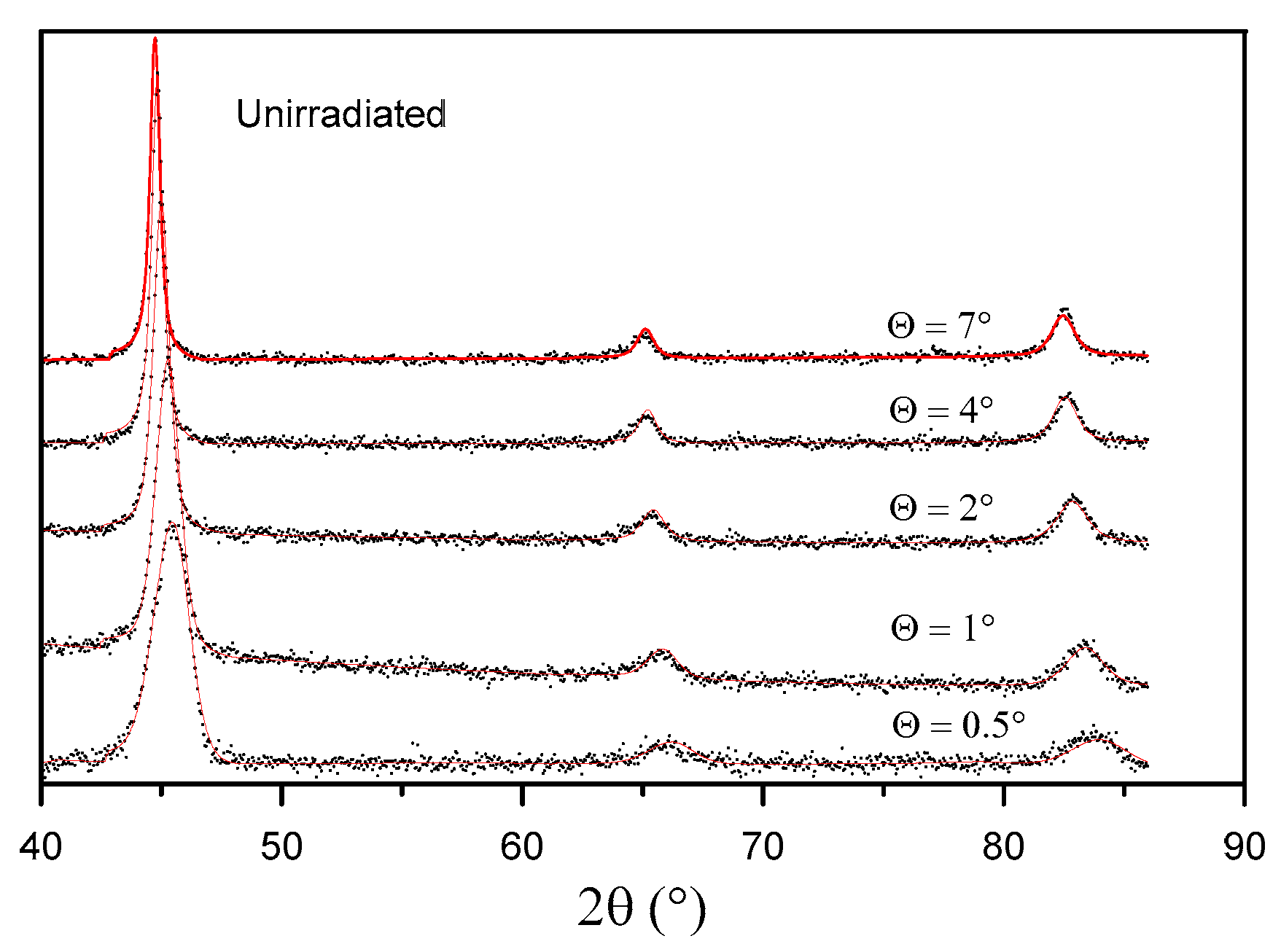
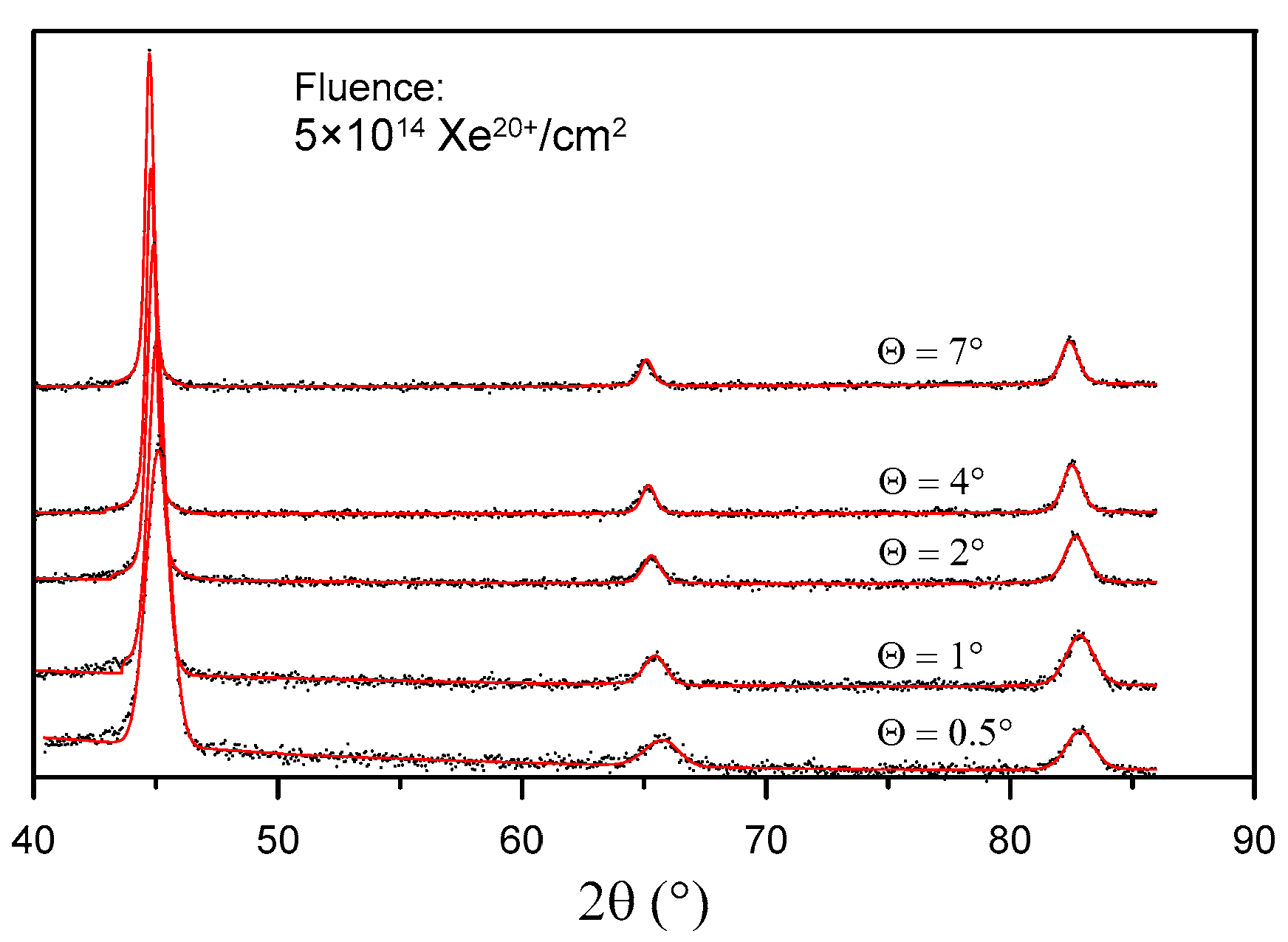
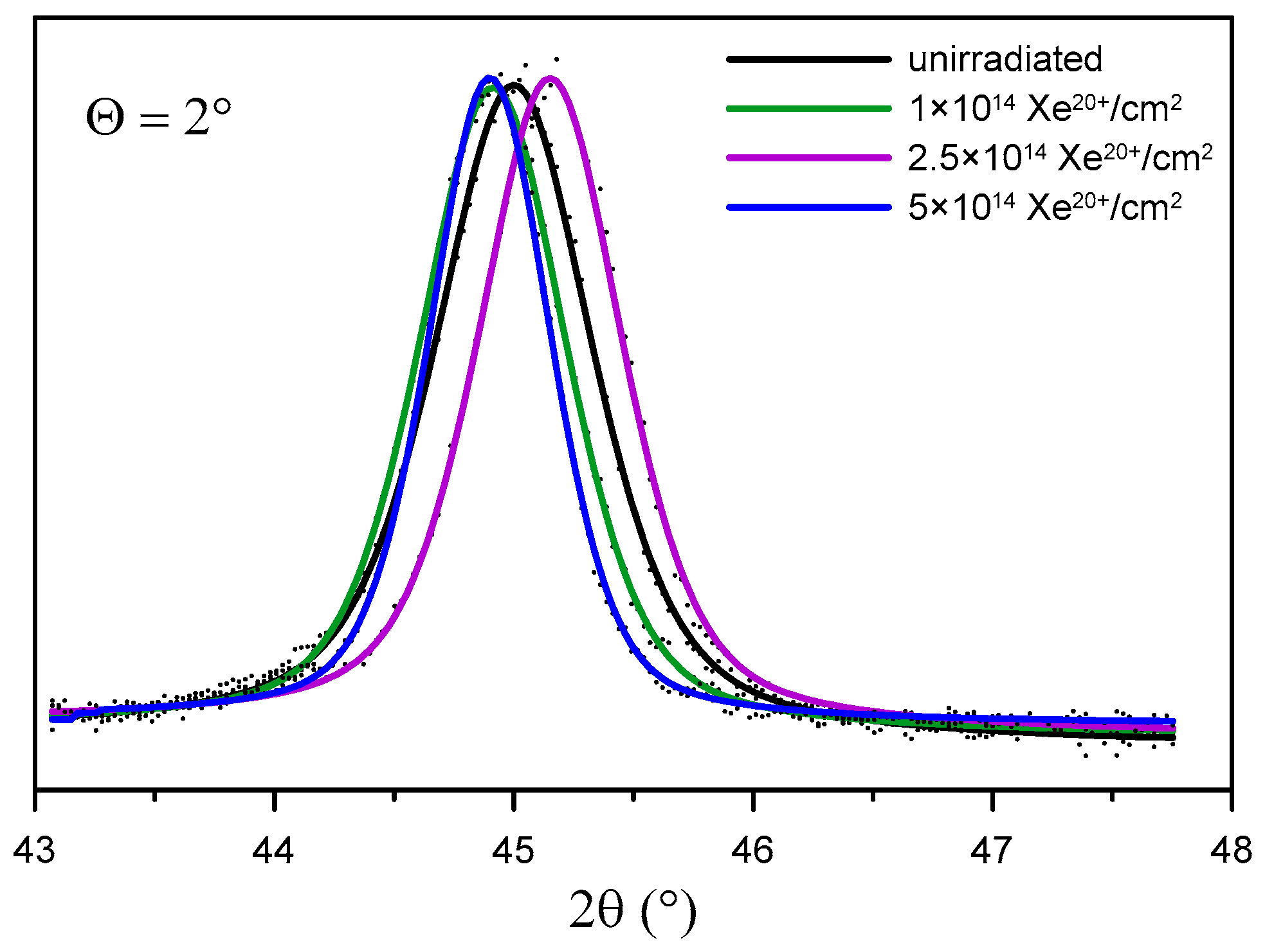
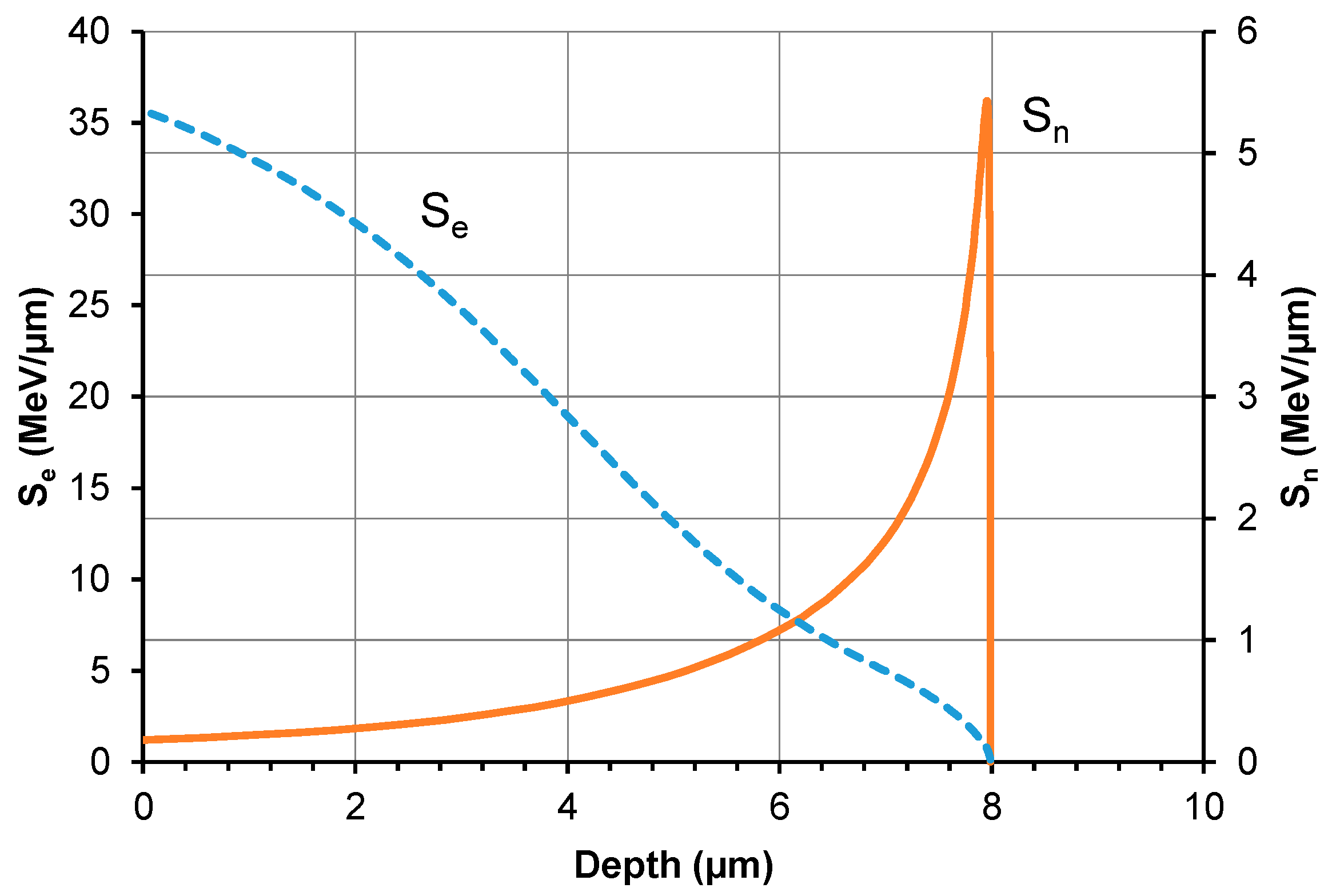
| Sample (Fluence)/Element | Fe | C | Cr | O | Mn | Si | Ni |
|---|---|---|---|---|---|---|---|
| Unirradiated | 93.1 (1) | 1.1 (2) | 1.5 (2) | 0.2 (2) | 0.4 (2) | 0.3 (2) | 0.1 (2) |
| 1.0 × 1014 Xe20+/cm2 | 93.7 (1) | 1.2 (2) | 1.6 (2) | 0.6 (2) | 0.4 (2) | 0.3 (2) | 0.1 (2) |
| 2.5 × 1014 Xe20+/cm2 | 93.4 (1) | 1.3 (2) | 1.6 (2) | 0.6 (2) | 0.4 (2) | 0.3 (2) | 0.1 (2) |
| 5.0 × 1014 Xe20+/cm2 | 92.6 (1) | 2.2 (2) | 1.5 (2) | 1.0 (2) | 0.4 (2) | 0.3 (2) | 0.1 (2) |
| Sample (Fluence)\Element | Fe | C | Cr | O | Mn | Si | Ni |
|---|---|---|---|---|---|---|---|
| Unirradiated | 84.2 (1) | 3.9 (2) | 1.5 (2) | 9.2 (2) | 0.3 (2) | 0.7 (2) | (2) |
| 1.0 × 1014 Xe20+/cm2 | 89.2 (1) | 3.6 (2) | 1.5 (2) | 4.8 (2) | 0.3 (2) | 0.5 (2) | 0.1 (2) |
| 2.5 × 1014 Xe20+/cm2 | 85.7 (1) | 4.4 (2) | 1.4 (2) | 7.4 (2) | 0.3 (2) | 0.6 (2) | 0.1 (2) |
| 5.0 × 1014 Xe20+/cm2 | 87.3 (1) | 3.8 (2) | 1.4 (2) | 6.3 (2) | 0.3 (2) | 0.6 (2) | 0.1 (2) |
| Incidence Angle Θ (°) | Penetration Depth (µm) | ||
|---|---|---|---|
| [hkl] | [011] | [002] | [112] |
| 0.5 | 0.06 (1) | 0.06 (1) | 0.06 (1) |
| 1 | 0.10 (1) | 0.10 (1) | 0.10 (1) |
| 2 | 0.19 (1) | 0.19 (1) | 0.19 (1) |
| 4 | 0.37 (1) | 0.37 (1) | 0.37 (1) |
| 7 | 0.60 (1) | 0.62 (1) | 0.63 (1) |
| Sample (Fluence) | A | Δa |
|---|---|---|
| Unirradiated | 2.8651 (1) | 0 |
| 1.0 × 1014 Xe20+/cm2 | 2.8658 (1) | 0.0007 (2) |
| 2.5 × 1014 Xe20+/cm2 | 2.8646 (1) | −0.0005 (2) |
| 5.0 × 1014 Xe20+/cm2 | 2.8667 (1) | 0.0016 (2) |
| Fluence/ Incidence Angle Θ (°) | Unirradiated | 1 × 1014 Xe20+/cm2 | 2.5 × 1014 Xe20+/cm2 | 5 × 1014 Xe20+/cm2 | ||||
|---|---|---|---|---|---|---|---|---|
| η (%) | D (nm) | η (%) | D (nm) | η (%) | D (nm) | η (%) | D (nm) | |
| 0.5 | 0.68 | 15 | 0.55 | 18 | 0.51 | 20 | 0.37 | 23 |
| 1 | 0.53 | 16 | 0.48 | 18 | 0.44 | 20 | 0.33 | 23 |
| 2 | 0.50 | 16 | 0.43 | 20 | 0.40 | 21 | 0.27 | 31 |
| 4 | 0.45 | 19 | 0.37 | 22 | 0.37 | 23 | 0.33 | 25 |
| 7 | 0.45 | 19 | 0.37 | 27 | 0.33 | 25 | 0.32 | 26 |
Disclaimer/Publisher’s Note: The statements, opinions and data contained in all publications are solely those of the individual author(s) and contributor(s) and not of MDPI and/or the editor(s). MDPI and/or the editor(s) disclaim responsibility for any injury to people or property resulting from any ideas, methods, instructions or products referred to in the content. |
© 2023 by the authors. Licensee MDPI, Basel, Switzerland. This article is an open access article distributed under the terms and conditions of the Creative Commons Attribution (CC BY) license (https://creativecommons.org/licenses/by/4.0/).
Share and Cite
Kamiński, M.; Budzyński, P.; Surowiec, Z.; Wiertel, M.; Zdorovets, M.V.; Kozlovskiy, A.; Waliszewski, J.; Magdziak, M. Effect of 160 MeV Xenon Ion Irradiation on the Tribological Properties and Crystal Structure of 100Cr6 Bearing Steel. Materials 2023, 16, 6660. https://doi.org/10.3390/ma16206660
Kamiński M, Budzyński P, Surowiec Z, Wiertel M, Zdorovets MV, Kozlovskiy A, Waliszewski J, Magdziak M. Effect of 160 MeV Xenon Ion Irradiation on the Tribological Properties and Crystal Structure of 100Cr6 Bearing Steel. Materials. 2023; 16(20):6660. https://doi.org/10.3390/ma16206660
Chicago/Turabian StyleKamiński, Mariusz, Piotr Budzyński, Zbigniew Surowiec, Marek Wiertel, Maxim V. Zdorovets, Artem Kozlovskiy, Janusz Waliszewski, and Marek Magdziak. 2023. "Effect of 160 MeV Xenon Ion Irradiation on the Tribological Properties and Crystal Structure of 100Cr6 Bearing Steel" Materials 16, no. 20: 6660. https://doi.org/10.3390/ma16206660
APA StyleKamiński, M., Budzyński, P., Surowiec, Z., Wiertel, M., Zdorovets, M. V., Kozlovskiy, A., Waliszewski, J., & Magdziak, M. (2023). Effect of 160 MeV Xenon Ion Irradiation on the Tribological Properties and Crystal Structure of 100Cr6 Bearing Steel. Materials, 16(20), 6660. https://doi.org/10.3390/ma16206660








